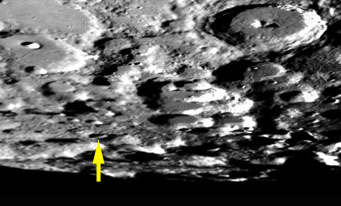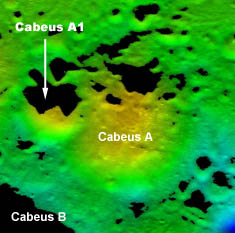Update: Yesterday NASA scientists announced that they've switched targets for October 9th's demolition derby near the Moon's south pole. The new target for the LCROSS spacecraft and its Centaur rocket is Cabeus, a flat-bottomed depression 61 miles (98 km) across. Centered at -84.9°, Cabeus is somewhat nearer the pole than the previous pick, dubbed Cabeus A1 (described below).
According to the project's website, "The general consensus of lunar experts led by the LCROSS science team is that Cabeus shows, with the greatest level of certainty, the highest hydrogen concentrations at the south pole." (The hydrogen is most likely in water ice, though other hydrogen-bearing compounds like ammonia could be there too.)
Original posting: Planetary scientists won't get a re-do when NASA's LCROSS spacecraft and its Centaur carrier rocket slam into the Moon on October 9th. They've got one chance only to strike a permanently shadowed and presumably water-rich crater floor near the lunar south pole. So for weeks they've anguished over where ground zero will be. As noted by project scientist Anthony Colaprete notes, the selection process spawned a "vigorous debate" among researchers.

Only 11 miles (17 km) across, the lunar crater Cabeus A1 might contain deposits of water ice. This view, taken with a 24-inch telescope, closely matches the lighting geometry and libration at the time of LCROSS's impact. Click here for a larger, labeled view.
New Mexico State Univ. / NASA-MSFC
With just under a month to go, they've announced their choice: an unnamed 11-mile-wide (17-km) craterlet astride the rim of Cabeus A. It's got desirable target characteristics — a flat boulder-free floor, for instance, and a location favorable for telescopes back on Earth to watch the resulting plume of debris that should balloon above the crash site.
Mostly, they've picked what they've dubbed Cabeus A1 because it's what one official calls a "sweet spot," a spot where detectors aboard the Lunar Reconnaissance Orbiter (which accompanied LCROSS to the Moon) hint that the always-dark dust might contain roughly 1½% water ice.
Neither Cabeus A1 nor nearby Cabeus A were on the list of candidate target craters announced back in July, and frankly the project's pick is surprisingly far from the lunar south pole (latitude –81½°). This is good news for both professional and amateur astronomers hoping to catch a glimpse of the impacts.

A robotic bird's-eye view of the lunar crater Cabeus A and A1, derived from Earth-based radar imaging. Colors indicate the terrain's elevation, with blue highest and yellow lowest. Black areas are inner rims hidden from the radar's view. Cabeus A is 30 miles (48 km) across.
NASA
Officials aren't saying how much they've determined about the crater, but LRO carries two instruments that potentially could have moved the bull's eye squarely onto Cabeus A1.
One is the Lyman-Alpha Mapping Project (LAMP)can literally see in the dark, using reflected ultraviolet radiation from starlight to image the permanently shadowed lunar terrain.
Meanwhile, the Lunar Exploration Neutron Detector (LEND) can detect the presence of hydrogen, which almost has to be in water ice, down to 100 parts per million. LEND was built by the Moscow's Space Research Institute, and as best I know this is the first and only time a Russian-built instrument has flown on one of NASA's spacecraft (not counting the International Space Station).
At today's press briefing, Daniel Andrews (LCROSS project
manager at NASA-Ames Research Center) assured everyone that the spacecraft was ready for its big finale. The team had a scare last month when an errant sensor caused wild thruster firings that squandered about half of the spacecraft's maneuvering fuel. Andrews also announced that the LCROSS mission has been dedicated to the memory of the late Walter Cronkite, the longtime television news reporter and anchor who followed NASA's missions from the Mercury program in the early 1960s to Space Shuttle.
So now it's time to start getting ready to observe lunar fireworks on October 9th. The timing, 4:30 a.m. Pacific Daylight Time, favors the big guns atop Mauna Kea in Hawaii in throughout western North America.
Sadly, I'll be in Puerto Rico that week — attending, ironically, a meeting of planetary scientists. Will someone please let us all know how things turn out?
 6
6
Comments
Paul Knight
September 12, 2009 at 1:22 pm
What size telescope can observe the impact plume--Are we talking 8" or 80"? Interesting article!
You must be logged in to post a comment.
Sean Walker
September 12, 2009 at 5:43 pm
I doubt a plume will be visible at all, but I'd love to be proven wrong.
When Kaguya impacted the Moon earlier this year, it was only detected with the 3.9 meter AAT in Australia, with exposures on a very sensitive CCD camera of 1-second each. Even then, impact barely registered. One observer using an 8-inch SCT and a webcam in Hong Kong failed to detect the impact.
What is important for this mission isn't visual observations but spectroscopic ones, which I suspect will be unaffected by the bright moon; any ice or water plume will register as a spike in the spectral regions of Hydrogen and Oxygen. If these are detected, that will be absolute proof of ice in these craters.
Cabeus (and Cabeus A, A1) will be well within the illuminated portion of the Moon, west of the central meridian. Although the small crater will be dark inside, the surrounding region will be in the Sun, so good luck, and post your observations here- even a negative observation is useful.
You must be logged in to post a comment.
Michael C. Emmert
September 20, 2009 at 4:02 pm
I think it was a fine thing the mission was dedicated to the late, great Walter Cronkite. He was a powerful advocate of space exploration.
And a seeker after the truth. Soon we will know, yea or nay, whether there is ice in the permanently shadowed craters of the Moon.
It there's water, we can build an international base on the Moon. If there's not, we need to hunker down and develop the space infrastructure needed to exploit Ceres and focus short-term goals towards building a better space transportation system.
You must be logged in to post a comment.
Michael C. Emmert
September 20, 2009 at 4:02 pm
I think it was a fine thing the mission was dedicated to the late, great Walter Cronkite. He was a powerful advocate of space exploration.
And a seeker after the truth. Soon we will know, yea or nay, whether there is ice in the permanently shadowed craters of the Moon.
It there's water, we can build an international base on the Moon. If there's not, we need to hunker down and develop the space infrastructure needed to exploit Ceres and focus short-term goals towards building a better space transportation system.
You must be logged in to post a comment.
Alex Donottraceme
September 25, 2009 at 1:27 pm
Are there any "reliable" time signals on the internet? I can imagine that combined frames of "webcam" video's from multiple sources (like 8"telescopes and up) could do the trick in imaging the impact.
Is there any software available (or in current public domain development) to combine frames of different video sources given different angular resolution and different spacial distrbution (and probably different framerates) that takes into account the "time signal start" of the video, the location of the viewer (which must be provided on entry of the video) and then match (pattern analysis of the image to correctly stretch and stack them) and stacks all the (reworked) imgages to get a cool impact video?
You must be logged in to post a comment.
Alex Donottraceme
September 25, 2009 at 1:27 pm
Are there any "reliable" time signals on the internet? I can imagine that combined frames of "webcam" video's from multiple sources (like 8"telescopes and up) could do the trick in imaging the impact.
Is there any software available (or in current public domain development) to combine frames of different video sources given different angular resolution and different spacial distrbution (and probably different framerates) that takes into account the "time signal start" of the video, the location of the viewer (which must be provided on entry of the video) and then match (pattern analysis of the image to correctly stretch and stack them) and stacks all the (reworked) imgages to get a cool impact video?
You must be logged in to post a comment.
You must be logged in to post a comment.